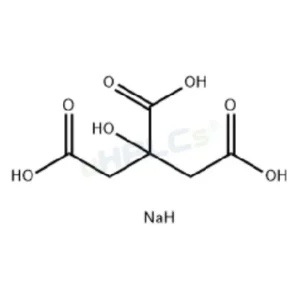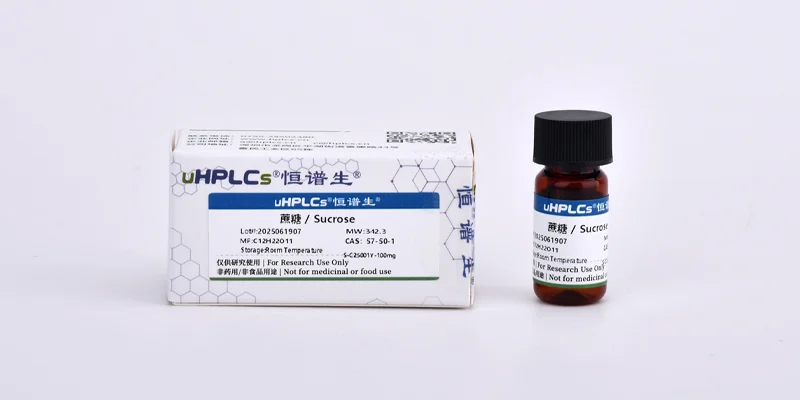
Uridine 5’-triphosphate Trisodium Salt (UTP-Na₃) Reference Standard | CAS 19817-92-6
Uridine 5’-triphosphate Trisodium Salt (UTP-Na₃) Reference Standard | CAS 19817-92-6 | High-Purity Reference Materiel Product Code: U-D25015X Chemical
Home » Portfolio Items » Sucrose Standard CAS 57-50-1 For Sale
1. Sucrose (CAS 57-50-1) is a naturally occurring disaccharide composed of glucose and fructose.
2. As a certified reference material (CRM), this sucrose standard is designed for use in analytical testing, calibration, and quality control.
3. It provides reliable traceability, high purity, and consistent performance, making it suitable for laboratories, research institutes, and industrial quality assurance applications.

| Parameter | Details |
|---|---|
| Product Code | S-C25001Y |
| CAS Number | 57-50-1 |
| Chemical Name | Sucrose |
| Molecular Formula | C₁₂H₂₂O₁₁ |
| Molecular Weight | 342.3 g/mol |
| Purity | ≥ 99% |
| Available Size | 100 mg (custom sizes available) |
| Storage Conditions | Room Temperature |
| Structural Formula | (Available upon request) |
| Category | Carbohydrate Standard |
*Supplied with COA (Certificate of Analysis) and SDS (Safety Data Sheet)
*Manufactured under ISO/IEC 17025 & GMP-compliant procedures
*Shipped in accordance with international regulations (non-hazardous, safe transport)
A: Regular laboratory-grade sucrose is often produced for general use, such as preparing culture media or as a reagent in non-critical experiments.
However, its purity and traceability may vary depending on the manufacturer.
In contrast, a sucrose standard reference material (SRM/CRM) is specifically manufactured to meet strict quality requirements.
It undergoes extensive testing and certification to confirm purity (≥99%), identity, and stability.
Each batch is accompanied by a Certificate of Analysis (COA), ensuring traceability and reproducibility.
This makes sucrose standards essential for calibration, quantitative analysis, and regulatory compliance in food, pharmaceutical, and research applications.
A: Sucrose standards are widely compatible with multiple analytical techniques, including HPLC, LC-MS, GC, ion chromatography, and UV spectrophotometry. They can be used to construct calibration curves, validate analytical methods, and quantify sucrose content in complex matrices such as food, beverages, and biological samples. For example, in HPLC analysis, sucrose standards are commonly used with refractive index detectors (RID) or evaporative light scattering detectors (ELSD). In LC-MS, sucrose is often analyzed in metabolic and pharmacokinetic studies. The standard ensures that analytical results are accurate, reproducible, and comparable across different laboratories.
A: Sucrose standards should be stored at room temperature in a tightly sealed container, away from moisture, direct sunlight, and strong oxidizing agents. Although sucrose is relatively stable under normal laboratory conditions, exposure to high humidity may lead to clumping or partial hydrolysis. If long-term storage is required, it is advisable to use desiccants and avoid frequent opening of the container. Proper storage conditions, as recommended in the COA and SDS, help maintain purity, integrity, and analytical performance throughout the product’s shelf life.
A: Each batch of sucrose standard is supplied with a Certificate of Analysis (COA), which confirms identity, purity, molecular weight, and storage requirements. A Safety Data Sheet (SDS) is also provided to ensure compliance with safety and regulatory guidelines. For laboratories working under ISO/IEC 17025 or GMP, these documents are essential for audit readiness, quality management, and regulatory submissions. They provide traceability and ensure that the material used in analytical testing meets internationally recognized standards.
A: Yes. While the standard package size is typically 100 mg, customized packaging is available to meet different laboratory requirements. For routine testing labs, larger bulk quantities may be provided, while research labs may prefer smaller aliquots to reduce waste and contamination risk. In some cases, sucrose standards can also be supplied as ready-to-use solutions with specified concentrations, minimizing preparation errors and saving time during method development or routine analysis.
A: Sucrose standards are critical in several fields:
*Food & Beverage Industry: Used in nutritional labeling, sugar profiling, and regulatory compliance testing.
*Pharmaceuticals: Applied in formulation studies, excipient quality control, and metabolic research.
*Environmental Science: Helps in monitoring sucrose in soil or water samples as part of ecological studies.
*Academic Research: Supports fundamental studies in carbohydrate metabolism, enzymology, and bioenergy.
By ensuring reliable calibration and validation, sucrose standards support data accuracy, product safety, and scientific integrity across industries.
A: No. Sucrose is classified as non-hazardous under most international transport regulations. It does not require special handling precautions beyond standard laboratory practices. However, as with all analytical standards, it should be handled with care to avoid contamination, and personal protective equipment (PPE) such as gloves and lab coats should be used. The accompanying SDS provides complete safety guidance.
– Product Name: Sucrose Standard
-CAS Number: 57-50-1
-Product Code: S-C25001Y
-Available Size: 100 mg (custom packaging on request)
📧 Contact Sales: sales@uhplcs.com
📞 Support Hotline: +86-0755-28502380
👉 [Request a Quote Now]

Uridine 5’-triphosphate Trisodium Salt (UTP-Na₃) Reference Standard | CAS 19817-92-6 | High-Purity Reference Materiel Product Code: U-D25015X Chemical

Glutathione (G-SH) Reference Standard | CAS 70-18-8 | High-Purity Reference Materiel Product Code: G-D25016X Chemical Name: Glutathione (G-SH)

Adenosine 5’-triphosphate Disodium Salt Reference Standard | CAS 987-65-5 | High-Purity Reference Materiel Product Code: A-D25014X Chemical Name:
WhatsApp us
Subscribe for exclusive offers and updates on new arrivals